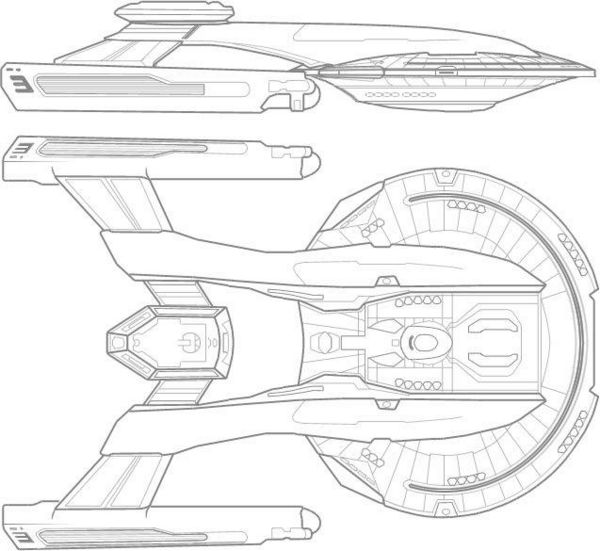KATANA-class Overview
Wall of Distinction (UNDER CONSTRUCTION) |
BuPers |
Library |
Home |
SF Engineering |
SF Intelligence |
SF JAG |
SF Marine Corps |
SF Medical |
SF Public Affairs |
SF Records |
SF Sciences |
SF SECIS
Federation News Network (FNN) |
UFP Dept. of Colonial Affairs |
UFP Educational, Scientific and Cultural Org.
Katana II
Ship Specifications
Class Information
- Class Name: Katana
- Classification: Warship, Long Range Anti-pirate Variant
- Type: Light Cruiser
- Model Number: II (Akira IVp)
Physical Specifications
- Length: 464 Meters
- Beam: 317 Meters
- Draft: 87 Meters
- Displacement: 3,855,394 Meters
Crew Compliment
- Total: 767
- Officers: 52
- Crew: 471
- Flight Officers: 30
- Flight Crew: 54
- Marines: 160
Propulsion Systems
- Warp:2x ILN-505 Mk X
- Impulse: 2x KRLT
- Main Reactor: FRAM-1200
- Secondary Reactor: FRIF-700 Network
- D-Warp: DIM-IV
- Velocity
- Standard Cruise: 7.00
- Maximum Cruise: 9.43
- 12 Hours: 9.80
- Emergency: 9.90
- Core Failure: 9.94
Armament
- 4x Phaser Type XI
- Range: 345,000 Kilometers
- Arcs
- Saucer Dorsal array
- Saucer ventral array
- Aft hull dorsal array Port and Starbord
- Aft hull ventral aft array Port and Starbord
- 4x Phaser Type XIa, Pulse Phaser Turrets
- Range: 300,000 Kilometers
- Arcs
- Foward firing Port and Starbord
- Aft firing Port and Starbord
- 3x Flux Torpedo Mk III Seeking/Directing
- Range: Flux 3,500,000 km, Photon 3,000,000 km
- Arcs
- 2x Foward
- 1x Aft
- 12x Point Defense Lasers, type III
- Range: 300,000 Kilometers
- Arcs
- Saucer dorsal turrets Port and Starbord
- Aft hull mid turrets Port and Starbord
- Deflector System: FD-10e enhanced cocoon multiphasic deflector shields
- Armor: Limited Ablative
Other Systems
- Transporters
- 4x Standard 6 Person
- 3x Combat, 12 Person
- 3x Emergency, 16 Person
- 2x Cargo
- Primary Hull Dorsal Aft Bay
- 4x Shuttlepod
- 3x Small Personnel Shuttle
- 2x Large Personnel Shuttle
- 3x D-warp Shuttle
- 1x Cargo Shuttle
- Secondary Hull Ventral Aft Bay
- Secondary Hull Ventral Foward Bay
- 1x Scout Ship
- 2x E-12 Runabout
Description
The KATANA-class is a long-range patrol variant of the MONTU. While maintaining the same overall dimensions, the class is distinguishable by altered weapon mounts and differences in the lower primary hull. These alterations increase the volume of the saucer so as to allow for the inclusion of larger shuttle bays. These bays are designed to hold combat shuttles and support craft which greatly increase the ability of a single KATANA to thoroughly scout a star system. This is invaluable in independent patrols, particularly in the anti-piracy role for which the ship was designed. While combat shuttles are of very limited use against proper warships, most pirate vessels are equipped with older systems and lack the redundancy and compartmentalization which make true military starships difficult to kill. Because piracy primarily exists in relatively sparsely populated sectors and border areas where an increased military presense is either not economically or politically feasible, increasing the effectiveness of a single small units was of paramount importance in the design. Instead of a single shuttle bay on the dorsal aft of the saucer, as a standard MONTU or AKIRA, the KATANA features three bays. The class keeps the original bay, but adds two bays to the expanded ventral saucer. The fighter bay is in the aft of the lower portion of the primary hull. The third bay carries two E-12 tactical warning and control runabouts for use with the combat shuttles and a single warp-capable scout ship to extend the long range scouting abilities of the mother ship.
The KATANA-class also features improved remote systems which allow for the ship to be manned by a smaller crew than a conventional cruiser. This frees necessary space for combat shuttle pilots and maintenance personnel and actually results in a slightly reduced overall crew as compared to a conventional MONTU.
The original MONTU-class cruiser is a descendent of the successful AKIRA-class warships that entered service early in the 2330's. The revolutionary catamaran configuration of the AKIRA's had proven itself as an efficient and robust design through diverse tactical engagements.
The KATANA incorporates the same SCIMITAR tactical sensor suite as a standard MONTU.
Application of ablative armor to critical areas of the structure, as deemed necessary from the AKIRA's, has also provided a much needed defensive boost to the refit design. Likewise the incorporation of a point defense system adds to defense by providing an additional defence against missile and projectile attacks.
The mark II model of the KATANA has been modified to handle the latest advanced combat shuttles which possess gravitic rather than conventional impulse drives. These craft were first deployed on the KRONSHTADT-class advanced escort carriers.
Because of the new drive system, the shuttles must be pushed clear of the hull before bringing their own drives to full power. This creates a vulnearability when they are deployed from a conventional carrier. As such, the mark II KATANA has been outfitted with laterally-mounted linear accelerators which serve as launch tubes. These literally fire the shuttles out of the side of the ship. Since the shuttle's own drive is on standby, they have limited intertial compensation during this phase so accelerations are limited, but it does push them well clear of the hull more efficiently than using tractor beams. Should the tubes be damaged, it is possible to deploy the shuttles through the aft recovery doors by using tractor beams. However, this operation is much slower.
